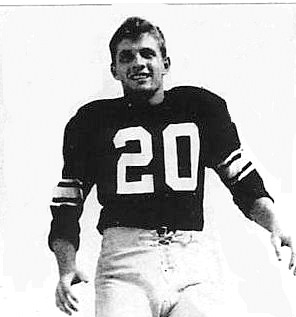
Tommy Brown
Stars of Yesterday: Tommy Brown
By Jim Joanos
Lots of thoughts ran through my mind when I got the message in February that one of my childhood heroes, Tommy Brown, had died. For a few moments I was eleven years old again and Tommy Brown was a star football, basketball, baseball, golf and track star at Tallahassee's Leon High School. I closed my eyes and could see him in that red football suit with his blonde hair poking out from under the front of his helmet. I could see the picture in the newspaper proclaiming him to be an "atomic bomb on cleats." I could see him winning the pole vault at the high school Northeast Conference Track Meet in Gainesville. I could also remember a few years after that when "Shine", as he was called, played football for the Florida State University Seminoles. I was in the Campbell Stadium bleachers on that ice cold day in October, 1950, when Brown punted the ball all the way from the Seminole sixteen yard line into the University of Tampa's end zone. That 84-yard punt is still the school record at FSU for the longest punt ever.
 |
Tommy Brown |
After his birth in Marianna, Thomas Edward Brown moved to Tallahassee with his family early in his childhood. At Leon High School he excelled in all sports that he participated in, racking up fifteen letters in five different sports. One of his friends has joked that his best sport was probably "shooting pool" but they did not give letters for that. In the late forties, Tallahassee had a youth center called the "Tallyoco" (short for, "Tallahassee Youth Council") Center, a popular place where students could hang out and play table tennis and shoot pool among a variety of other activities. Brown was one of the "stars." However, because football was the high profile sport that it was, it was in football that Brown drew the most attention. At Leon, he played on the varsity from the ninth grade through his senior season. In two of his seasons, the first (1943) and the last (1946) the Leon team won the important Northeast Florida Conference ("NEC"). During that span, he played for three different Leon head coaches: Amos Godby (1943), Tom Brown (no relation, 1944 & 45), and John Westburg (1946). In his senior season, Brown was the team Captain and was elected by his teammates as the Most Valuable Player at the end of the season. He was also named to the first team of the NEC All-Star team. Sometime in high school he sustained a shoulder injury that would plague him thereafter and eventually limited his college football abilities.
As World War II had recently ended when Brown graduated from Leon in 1947, military service was still a high priority for most young men at the time. Brown joined the United States Air Force. After serving a short while as an airman, he got an appointment to the United States Military Academy. He entered West Point in time to play Freshman football during the 1948 season. For the frosh, he alternated as the quarterback and played halfback on defense. For the 1949 season, he was a valuable member of the varsity team as a back (mostly playing defense) and punting for the Army team that went undefeated that year. His punting and an interception in the end zone made him the star of the Michigan game in which Army beat the Woverines 21-7 and ended a Michigan 25-game winning streak. Incidentally, a young assistant coaching Army's backs that season was Vince Lombardi. The head coach was the also legendary, Earl "Red" Blaik.
Brown was not too crazy about being so far from home so he transferred to FSU in time to become a member of the 1950 Seminoles team. The five foot ten inch, 150-pound athlete immediately became a major contributor. In his first game as a Seminole playing at Troy State, he scored the first two touchdowns of the game, the first on a reverse and the second by way of a long pass reception. The team went on to an 8-0 season making Brown a member of teams that were undefeated in two consecutive seasons, 1949 Army and 1950 FSU. Brown played football for FSU also in 1951 and 52, mostly punting and playing defense back despite injuries. On two occasions, he intercepted three passes in the same game. The school record of three in a game by an individual that Brown accomplished in 1952 was not surpassed until 1998, forty-six years later. In a Tallahassee Democrat article written by Bill McGrotha in 1978, FSU Coach Don Veller is quoted as describing Brown's abilities thusly, "I don't know of anybody ever out there who was a better defensive back than Tommy." He went on to say that Brown was "completely motivated, the kind that played his best against the tougher opponents." He also described Brown as "a tremendous student, with very little effort, and he was a gentleman, I might add."
While at FSU Brown was also a star on the golf team. After college he continued to play a lot of golf, and even went professional for a period of time. Later he settled in Tallahassee and got into business and construction. He thereafter continued winning amateur golf tournaments and loved fishing. While Tommy Brown is gone, the memories of those who had the good luck to watch him compete will long live. Thanks, Shine, for the good show!